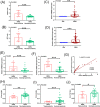ARID5B-mediated LINC01128 epigenetically activated pyroptosis and apoptosis by promoting the formation of the BTF3/STAT3 complex in β2GPI/anti-β2GPI-treated monocytes
- PMID: 38224186
- PMCID: PMC10788880
- DOI: 10.1002/ctm2.1539
ARID5B-mediated LINC01128 epigenetically activated pyroptosis and apoptosis by promoting the formation of the BTF3/STAT3 complex in β2GPI/anti-β2GPI-treated monocytes
Abstract
Background: Alterations of the trimethylation of histone 3 lysine 4 (H3K4me3) mark in monocytes are implicated in the development of autoimmune diseases. Therefore, the purpose of our study was to elucidate the role of H3K4me3-mediated epigenetics in the pathogenesis of antiphospholipid syndrome (APS).
Methods: H3K4me3 Cleavage Under Targets and Tagmentation and Assay for Transposase-Accessible Chromatin were performed to determine the epigenetic profiles. Luciferase reporter assay, RNA immunoprecipitation, RNA pull-down, co-immunoprecipitation and chromatin immunoprecipitation were performed for mechanistic studies. Transmission electron microscopy and propidium iodide staining confirmed cell pyroptosis. Primary monocytes from patients with primary APS (PAPS) and healthy donors were utilised to test the levels of key molecules. A mouse model mimicked APS was constructed with beta2-glycoprotein I (β2GPI) injection. Blood velocity was detected using murine Doppler ultrasound.
Results: H3K4me3 signal and open chromatin at the ARID5B promoter were increased in an in vitro model of APS. The epigenetic factor ARID5B directly activated LINC01128 transcription at its promoter. LINC01128 promoted the formation of the BTF3/STAT3 complex to enhance STAT3 phosphorylation. Activated STAT3 interacted with the NLRP3 promoter and subsequently stimulated pyroptosis and apoptosis. ARID5B or BTF3 depletion compensated for LINC01128-induced pyroptosis and apoptosis by inhibiting STAT3 phosphorylation. In mice with APS, β2GPI exposure elevated the levels of key proteins of pyroptosis and apoptosis pathways in bone marrow-derived monocytes, reduced the blood velocity of the ascending aorta, increased the thrombus size of the carotid artery, and promoted the release of interleukin (IL)-18, IL-1β and tissue factor. Patients with PAPS had the high-expressed ARID5B and LINC01128, especially those with triple positivity for antiphospholipid antibodies. Moreover, there was a positive correlation between ARID5B and LINC01128 expression.
Conclusion: This study indicated that ARID5B/LINC01128 was synergistically upregulated in APS, and they aggravated disease pathogenesis by enhancing the formation of the BTF3/STAT3 complex and boosting p-STAT3-mediated pyroptosis and apoptosis, thereby providing candidate therapeutic targets for APS.
Highlights: The H3K4me3 mark and chromatin accessibility at the ARID5B promoter are increased in vitro model mimicked APS. ARID5B-mediated LINC01128 induces pyroptosis and apoptosis via p-STAT3 by binding to BTF3. ARID5B is high- expressed in patients with primary APS and positively correlated with LINC01128 expression. OICR-9429 treatment mitigates pyroptosis and related inflammation in vivo and in vitro models mimicked APS.
Keywords: APS; ARID5B; LINC01128; apoptosis; epigenetics; pyroptosis; thrombosis.
© 2024 The Authors. Clinical and Translational Medicine published by John Wiley & Sons Australia, Ltd on behalf of Shanghai Institute of Clinical Bioinformatics.
Conflict of interest statement
The authors declare they have no conflicts of interest.
Figures








Similar articles
-
H3K4me3-Mediated FOXJ2/SLAMF8 Axis Aggravates Thrombosis and Inflammation in β2GPI/Anti-β2GPI-Treated Monocytes.Adv Sci (Weinh). 2024 Jun;11(24):e2309140. doi: 10.1002/advs.202309140. Epub 2024 Apr 19. Adv Sci (Weinh). 2024. PMID: 38639399 Free PMC article.
-
Platelet-derived microparticles stimulated by anti-β2GPI/β2GPI complexes induce pyroptosis of endothelial cells in antiphospholipid syndrome.Platelets. 2023 Dec;34(1):2156492. doi: 10.1080/09537104.2022.2156492. Platelets. 2023. PMID: 36550078
-
The role of thrombospondin-1 in the pathogenesis of antiphospholipid syndrome.J Autoimmun. 2020 Dec;115:102527. doi: 10.1016/j.jaut.2020.102527. Epub 2020 Jul 21. J Autoimmun. 2020. PMID: 32709480
-
Pyroptosis-triggered pathogenesis: New insights on antiphospholipid syndrome.Front Immunol. 2023 Mar 31;14:1155222. doi: 10.3389/fimmu.2023.1155222. eCollection 2023. Front Immunol. 2023. PMID: 37063905 Free PMC article. Review.
-
Antiphospholipid syndrome: 30 years and our contribution.Int J Rheum Dis. 2015 Feb;18(2):233-41. doi: 10.1111/1756-185X.12438. Epub 2014 Dec 19. Int J Rheum Dis. 2015. PMID: 25524556 Review.
Cited by
-
Paris saponin VII attenuates psoriasiform inflammation by regulating STAT3/NFκB signaling pathway and Caspase-1-induced pyroptosis.Mol Med. 2025 May 22;31(1):200. doi: 10.1186/s10020-025-01253-y. Mol Med. 2025. PMID: 40405066 Free PMC article.
-
Wuwei Kushen Changrong capsule alleviates DSS-induced colitis in mice via inhibition of NLRP3 inflammasome and STAT3 pathway.Front Pharmacol. 2024 Sep 12;15:1423012. doi: 10.3389/fphar.2024.1423012. eCollection 2024. Front Pharmacol. 2024. PMID: 39329121 Free PMC article.
References
-
- Guzmán‐Martín CA, Juárez‐Vicuña Y, Domínguez‐López A, et al. lncRNAs dysregulation in monocytes from primary antiphospholipid syndrome patients: a bioinformatic and an experimental proof‐of‐concept approach. Mol Biol Rep. 2023;50(1):937‐941. - PubMed
-
- Patsouras MD, Karagianni P, Kogionou P, Vlachoyiannopoulos PG. Differential CpG methylation of the promoter of interleukin 8 and the first intron of tissue factor in antiphospholipid syndrome. J Autoimmun. 2019;102:159‐166. - PubMed
Publication types
MeSH terms
Substances
Grants and funding
LinkOut - more resources
Full Text Sources
Molecular Biology Databases
Miscellaneous
